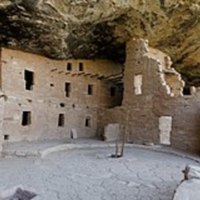Spruce Tree House
Dublin Core
Title
Spruce Tree House
Subject
Spruce Tree House
Cliff Dwelling
Mesa Verde
Description
Mexican-Spanish missionaries and explorers Francisco Atanasio Domínguez and Silvestre Vélez de Escalante, seeking a route from Santa Fe to California, faithfully recorded their travels in 1776. They reached Mesa Verde (green plateau) region, which they named after its high, tree-covered plateaus, but they never got close enough, or into the needed angle, to see the ancient stone villages.[111][112] They were the first Europeans to travel the route through much of the Colorado Plateau into Utah and back through Arizona to New Mexico.[113]
The Mesa Verde region has long been occupied by the Utes, and an 1868 treaty between them and the United States government recognized Ute ownership of all Colorado land west of the Continental Divide. After there had become an interest in land in western Colorado, a new treaty in 1873 left the Ute with a strip of land in southwestern Colorado between the border with New Mexico and 15 miles north. Most of Mesa Verde lies within this strip of land. The Ute wintered in the warm, deep canyons and found sanctuary there and the high plateaus of Mesa Verde. Believing the cliff dwellings to be sacred ancestral sites, they did not live in the ancient dwellings.[111]
Occasional trappers and prospectors visited, with one prospector, John Moss, making his observations known in 1873.[114] The following year, Moss led eminent photographer William Henry Jackson through Mancos Canyon, at the base of Mesa Verde. There, Jackson both photographed and publicized a typical stone cliff dwelling.[114] Geologist William H. Holmes retraced Jackson's route in 1875.[114] Reports by both Jackson and Holmes were included in the 1876 report of the Hayden Survey, one of the four federally financed efforts to explore the American West. These and other publications led to proposals to systematically study Southwestern archaeological sites.[114]
In her quest to find Ancestral Puebloan settlements, Virginia McClurg, a journalist for the New York Daily Graphic, visited Mesa Verde in 1882 and 1885. Her party rediscovered Echo Cliff House, Three Tier House, and Balcony House in 1885; these discoveries inspired her to protect the dwellings and artifacts.[70][115]
The Mesa Verde region has long been occupied by the Utes, and an 1868 treaty between them and the United States government recognized Ute ownership of all Colorado land west of the Continental Divide. After there had become an interest in land in western Colorado, a new treaty in 1873 left the Ute with a strip of land in southwestern Colorado between the border with New Mexico and 15 miles north. Most of Mesa Verde lies within this strip of land. The Ute wintered in the warm, deep canyons and found sanctuary there and the high plateaus of Mesa Verde. Believing the cliff dwellings to be sacred ancestral sites, they did not live in the ancient dwellings.[111]
Occasional trappers and prospectors visited, with one prospector, John Moss, making his observations known in 1873.[114] The following year, Moss led eminent photographer William Henry Jackson through Mancos Canyon, at the base of Mesa Verde. There, Jackson both photographed and publicized a typical stone cliff dwelling.[114] Geologist William H. Holmes retraced Jackson's route in 1875.[114] Reports by both Jackson and Holmes were included in the 1876 report of the Hayden Survey, one of the four federally financed efforts to explore the American West. These and other publications led to proposals to systematically study Southwestern archaeological sites.[114]
In her quest to find Ancestral Puebloan settlements, Virginia McClurg, a journalist for the New York Daily Graphic, visited Mesa Verde in 1882 and 1885. Her party rediscovered Echo Cliff House, Three Tier House, and Balcony House in 1885; these discoveries inspired her to protect the dwellings and artifacts.[70][115]
Source
https://en.wikipedia.org/wiki/Mesa_Verde_National_Park
Publisher
Wikipedia
Coverage
37.1657° N, 108.4916° W
Collection
Citation
“Spruce Tree House ,” Dominican University SOIS Omeka Site, accessed February 22, 2025, http://108.166.64.190/omeka222/items/show/2395.
